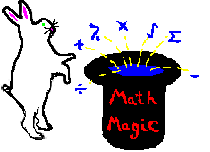

[ Home ] [ FOIL Method ] [ Double & Half Method ] [ Squaring Numbers ] [ Squaring Num End In 5 ] [ Squaring Num End In 6 ] [ Squaring Num End In 7 ] [ Squaring Num End In 8 ] [ Squaring Num End in 9 ] [ Squaring Nums 40-49 ] [ Squaring Nums 50-59 ] [ Squaring Nums 90-99 ] [ Difference of 2 Squares ] [ Mult Nums End in 5 ] [ Mult Nums One's Add 10 ] [ Mult Nums One's Add 5 ] [ Mult Nums Same Ten's Digits ] [ Mult Nums Tens Add 10 ] [ Mult Nums Less 100 ] [ Mult Nums More 100 ] [ Mult Nums More 100 Less 100 ] [ AB + BC ] [ AA + 2AA ] [ AA + 3AA ] [ AA + 7AA ] [ AA + 10AA ] [ Mult Nums Less 1000 ] [ Mult Nums More 1000 ] [ Add 2 Squares ] [ Product of 4 Nums ] [ Adding Consecutive Squares ] [ Squaring: 101a ] [ Adding Squares #2 ]
(*View/Download
.pdf file)
(*)
Multiplying And Adding Numbers In The Form:
ab + bc:
A.
From algebra we can factor:
ab + bc = b(a +
c)
B.
Using numbers instead of variables we get the following:
1.
Take out the number that both sides have in common.
2.
Add the remaining numbers.
3.
Multiply the number in step 1 with the result in step 2 for the answer.
Ex [1] 15 x 12 + 15 x 8 =_________.
a)
Rewrite in the form 15 x (12 + 8).
b)
15 x 20 = 300.
c)
The answer is 300.
Ex [2] 16 x 16 + 16 x 17 =_________.
a)
Rewrite in the form 16 x (16 + 17).
b)
16 x 33 = 48 x 11. See Double
and Half.
c)
48 x 11 = 528. See Multiplying
by 11.
C. Ex [2] uses a variety of different methods. This is just how I
would do the problem, but there are many different ways of going about solving
this problem. This is up to you.
Back
to top

